
Gargoyles are a type of architectural element that have been used for centuries on buildings and structures around the world. They are typically depicted as fearsome creatures with grotesque features, and are often found on Gothic-style buildings.
The origins of gargoyles can be traced back to medieval Europe, and they have a rich history and symbolism.
The word “gargoyle” comes from the French word “gargouille”, which means “throat” or “gullet”. The name is thought to have originated from the Latin word “gurgulio”, which means “gullet” or “throat”.

The name is fitting, as the primary function of the gargoyle was to act as a spout to carry away rainwater from the roofs of buildings.
The earliest known examples of gargoyles can be found on the ancient Egyptian and Roman structures, where they were used to channel water away from the building.
However, it was during the medieval period in Europe that the use of gargoyles as decorative elements on buildings really took off.

During the medieval period, the Catholic Church was one of the most powerful institutions in Europe. The Church commissioned many grand and elaborate buildings, including cathedrals, monasteries, and churches. These buildings featured intricate and ornate architectural elements, including gargoyles.
Gargoyles were used to decorate the exteriors of these buildings, and they served both a practical and symbolic purpose.

As spouts, they helped to channel water away from the building and prevent water damage.
But they also served a symbolic purpose, as they were often used to depict biblical figures and demons. These figures were meant to act as a warning to the people, representing the dangers of sin and the consequences of bad behavior.

